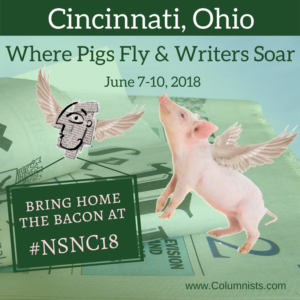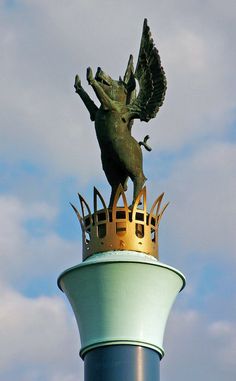By Lisa Smith Molinari
NSNC President
 Sometimes, we writers take ourselves too seriously.
Sometimes, we writers take ourselves too seriously.Many have implied that they wouldn’t exist without their craft, claiming, “I write; therefore, I am.” However, a more realistic statement for columnists today might be, “I write; therefore, I have a day job to pay the bills.”
Perhaps a more apropos mantra for those of us determined to succeed at column-writing without losing our senses of humor would be, “I’ll give my columns away for free when pigs fly.”
And what better place for columnists to convene and learn about bringing home the bacon than Cincinnati, Ohio, a city known for flying pigs.
Yes, that’s right, Cincinnati is our host for NSNC’s 42nd Annual Conference, to be held at the Kingsgate Marriott, June 7 to 10, 2018, and what you see pictured here is our Cincinnati conference logo. Before registration opens next month, curious prospective attendees might want to know, “Now…what’s this about flying pigs?”
Unlike those philosophizing writers, Cincinnati refuses to take itself too seriously. Which is why it chose the Flying Pig as its enduring icon, a symbol of its industrial history and playful personality.
It all started when Cincinnati was nicknamed “Porkopolis” because it was the world’s leading pork-packing city by the 1840s, processing more than a quarter of a million hogs per year.
 But the winged version of these porcine beasts did not become an emblem in Cincinnati until 1988, when renowned artist Andrew Leicester was commissioned to create a statue for the 200th birthday of the city. The statue was to be placed at Bicentennial Commons at Sawyer Point (now known as Flying Pig Park). Leicester used references from Cincinnati’s history and culture to sculpt the gateway piece, which is comprised of four 30-foot-high riverboat stacks, each one topped with a 3-foot winged bronze pig, its hooves raised high in apparent exultation.
But the winged version of these porcine beasts did not become an emblem in Cincinnati until 1988, when renowned artist Andrew Leicester was commissioned to create a statue for the 200th birthday of the city. The statue was to be placed at Bicentennial Commons at Sawyer Point (now known as Flying Pig Park). Leicester used references from Cincinnati’s history and culture to sculpt the gateway piece, which is comprised of four 30-foot-high riverboat stacks, each one topped with a 3-foot winged bronze pig, its hooves raised high in apparent exultation.Although the phrase “when pigs fly” is a hyperbolic figure of speech used to reference something impossible, Leicester’s porky aviators were applied in a more heavenly sense.
The four skyward swine atop the riverboat stacks represent “the angelic spirits of all the pigs that were slaughtered and were building blocks of Cincinnati’s prosperity. So they’re up there paying one last tribute – singing the ‘Hallelujah Chorus’ – to all their [dead] brethren who flowed into the river,” Leicester said.
Initially, Cincinnatians were not comfortable with pigs being a symbol of their “Queen City.” A hot debate and media blitz ensued. At the height of the fervor, city council members donned snouts, the public carried signs that read “Let the pigs fly!” and a huge live hog and several pink-ribboned piglets were let loose at a Town Hall meeting.
In the end, the politicians realized they were taking themselves too seriously, and the sculpture was endorsed without further protest.
However, the media attention propelled the soaring oinker symbolism even further, as many local groups adopted the flying pig as the unofficial emblem of Cincinnati. Winged sows appeared on T-shirts, hats, coffee cups, souvenirs, logos, and letterheads.
In 1999, the city asked for name suggestions when it decided to launch an annual marathon. Initially offered as a joke, the idea of “The Flying Pig Marathon” was ultimately adopted as the official event name. The founder of the marathon, Bob Coughlin, saw the name’s marketing potential, saying, “We didn’t think too hard about it. It came out of trying not to be too serious.”
Good thing, because The Flying Pig Marathon is in its 19th year, attracting thousands of runners from all 50 states and several foreign countries.
And in 2000, The Big Pig Gig was launched – a public art project to build the flying pig statues one can spot all over the city today.
Although Porkopolis has cleaned up its act since its industrial pig-slaughtering days, Cincinnati has decided to embrace its history rather than hide it. Even Cincinnati-based cleaning-product mogul Procter & Gamble must give some credit to swine. The company was founded in 1837 during the height of Cincinnati’s pork industry, making soap and candles from the pork fat left over from the slaughtering process.
Maybe that’s where we got the term “hogwash.”
Regardless, next month conference registration opens for the National Society of Newspaper Columnists’ 2018 Annual Conference, June 7 to 10at the Kingsgate Marriott in Cincinnati, the City of Flying Pigs and endless possibilities.
***
 Lisa Smith Molinari is a syndicated columnist, author, blogger and speaker, whose “Meat & Potatoes of Life” column appears weekly in civilian and military newspapers across the United States, as well as on her award-winning blog, www.themeatandpotatoesoflife.com
Lisa Smith Molinari is a syndicated columnist, author, blogger and speaker, whose “Meat & Potatoes of Life” column appears weekly in civilian and military newspapers across the United States, as well as on her award-winning blog, www.themeatandpotatoesoflife.com
